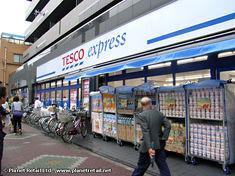
Ever heard of Me & My, Smile.dk, E-Rotic or Captain Jack? No? Well, in Japan they are more popular and better known than other artists such as Britney Spears, Madonna and even Justin Bieber. And Tesco has now added itself to the list of global names who have failed to make the grade in Japan. The news last week that Tesco, which owns 129 small stores in the Greater Tokyo area, is to sell off its Japanese business after eight years attempting to make inroads into the market was a further sign that success in the west does not always translate when it comes to cracking the Ear East.
It is no secret that consumption in Japan is static, if not falling, as an ageing population and smaller families contribute to tough trading in the island nation. Between 1995 and 2010, the average annual expenditure per household on fruit declined by 27.1 per cent from ¥47,467 to ¥34,580 (£381) as a weakened economy and changes in consumer demand began to hit, according to Japan’s Ministry of Internal Affairs and Communications Statistics.
“Japan is a static economy and has been for almost 20 years,” says John Giles, divisional director at analyst Promar International. “Tesco is very keen on the fast-growing economies in eastern Europe, China and the Pacific Rim. It’s been a huge success story for them under Sir Terry Leahy and in some ways this is a bold decision to say ‘let’s not muck about, let’s concentrate on the UK, Asia and the US’.”
Announcing the news, Tesco chief executive Philip Clarke “concluded that we cannot build a sufficiently scalable business”. You can see his point. Initially entering the market in 2003, Tesco acquired local player C Two-Network but has been unable to step up its growth through further acquisition, relying solely on organic growth. C Two-Network, which had fairly modest revenues of less than £500m from 78 stores when it was acquired, proved to be too small an option. The acquisition of 27 Fre’c outlets in 2004 did little to add to this. Its fresh produce content largely mirrors Tesco Express stores in the UK while the display bears more resemblance to discounters over here, with product piled high and even on the pavement.
Tesco suppliers hoping to find a route into Asia via Group Food Sourcing will now have to focus on other markets.
Elsewhere in Asia, Tesco has moved quickly to implement its hypermarket strategy - quickly buying up businesses in Thailand, South Korea, Malaysia and China before opening smaller stores.
In Tokyo, where the plan was to capitalise on the cash of 36 million people, the price of land rents prevented rapid growth and the City Planning Law restricting large store growth in 2007 further limited Tesco’s options. The developed market proved a hurdle for Tesco, competing against the likes of 7-Eleven, Lawson, FamilyMart and Ministop. “There is a trend for local, neighbourhood stores now the population is ageing and transport to large stores is an issue,” says Robert Gregory, research director for Planet Retail. “Japan has thousands of convenience stores but not many large ones where you can achieve economies of scale.”
So what are the implications of Tesco’s departure? Carrefour’s similar failure to be successful in the market - coming up against media criticism for its use of category management rather than sourcing wholesale - leaves Walmart the only international supermarket left there. And Walmart is struggling, with its low price strategy failing to engage a consumer who prefers premium quality.
Tesco, meanwhile, knows that attention will now turn to the struggle with Fresh & Easy in the US. And it would be a much bigger defeat in the battle with Walmart to have to retreat.
Tesco said that it’s business as usual in Japan until it undertakes a formal sale process in the coming months but it’s clear, in terms of business strategy, that its mind is already elsewhere.